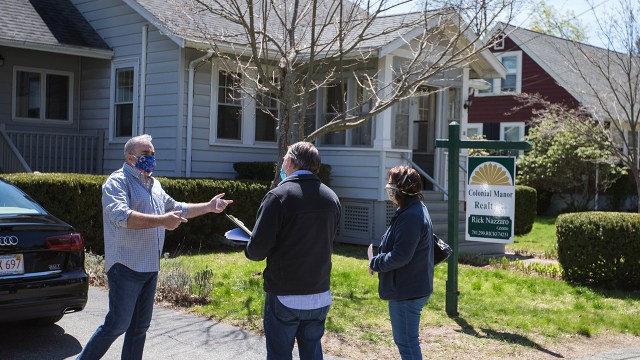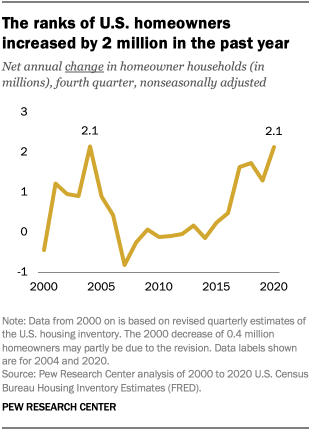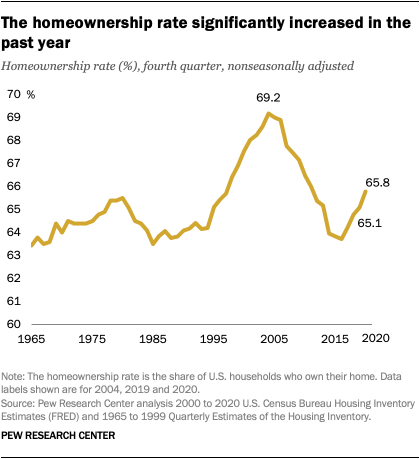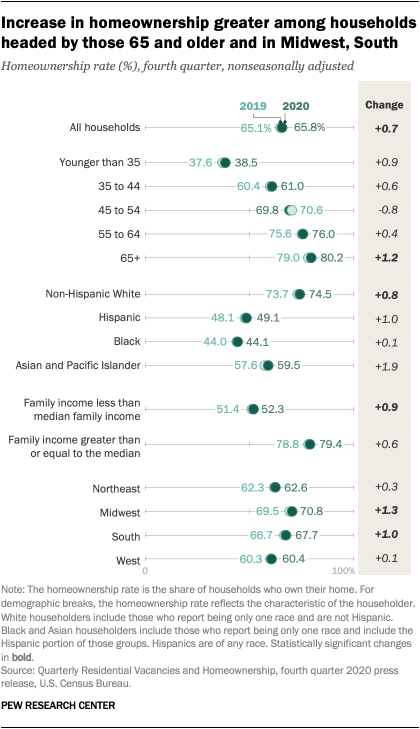
The American dream of homeownership has not been dampened by the COVID-19 pandemic and the economic downturn it has caused.
In the fourth quarter of 2020 there were an estimated 82.8 million owner-occupied households in the United States, according to recently released Census Bureau data. The number of homeowners increased by an estimated 2.1 million over the prior year. Based on fourth-quarter nonseasonally adjusted data, this matches the largest prior net increase in homeowners that occurred during the housing boom between 2003 and 2004 (2.1 million).
After falling in the immediate aftermath of the coronavirus outbreak, sales of existing homes in the U.S. have bounced back, and annual sales reached their highest level since 2006. The robust activity in residential real estate raises questions about whether the pandemic is associated with an expansion of homeownership.
Counts of occupied housing units and homeowners are from the Current Population Survey/Housing Vacancy Survey. This survey is not the only Census Bureau survey providing estimates of the home ownership rate, but it is the only one generating estimates on a quarterly, as opposed to annual, basis. The number of homeowners and homeownership rates use the revised estimates from the second quarter of 2000 forward. The bureau has not issued revised estimates for quarters before the second quarter of 2000.
The coronavirus pandemic has impacted the homeownership data collection during 2020. Households are in the survey sample for a total of 8 months. They are interviewed in person twice. The Census Bureau suspended all in-person interviews from March 2020 until June 2020. In lieu of in-person interviews, the bureau tried to conduct telephone interviews. Personal interviewing was resumed beginning in July in certain areas of the country and by September was feasible throughout the country. For November and December, in-person interviewing was suspended for some areas. As a result, response rates to the survey have been lower than before the pandemic. The response rates for October, November and December 2020 were 81%, 80% and 77%, respectively. The average response rate for the same months of 2019 was 84%.
The changes in data collection procedures could have impacted estimates of the homeownership rate for the fourth quarter of 2020. Based on the full sample, the homeownership rate increased 0.7 percentage points compared with a year earlier. The Census Bureau released supplemental estimates for the fourth quarter of 2019 and 2020 where the sample was limited to geographies where in-person interviews were permitted in the fourth quarter of 2020. On this basis the estimated homeownership rate increased 0.4 points.
The estimates of 2019 median adjusted household income were derived from the 2020 Current Population Survey, Annual Social and Economic Supplements (ASEC). The ASEC microdata files were provided by the IPUMS at the University of Minnesota. The estimates are in 2019 dollars and scaled to reflect a three-person household.
Some of the growth in homeownership is attributable to overall growth in the economy and in the number of households in the U.S. over time. The addition of 2.1 million homeowners in 2020 represents an annual increase of 2.6%. This is the seventh largest percentage increase in homeowners dating back to 1965.
A substantial amount of the increase in homeowners has occurred since the onset of the coronavirus outbreak in February. The net number of homeowners is up 1.6 million since the first quarter of 2020.
Perhaps not surprisingly, the boom in the number of homeowners also boosted the homeownership rate. As of the fourth quarter of 2020, 65.8% of households own their homes, up from 65.1% a year earlier. This 0.7 percentage point increase in the homeownership rate is not the largest on record (the rate increased 0.9 points from 1994 to 1995), but it is large nonetheless.
The 2020 homeownership rate remains below the historical peak of 69.2% in 2004. Dating back to 1965, the homeownership rate has averaged 65.3% (based on fourth-quarter data).
The increase in the homeownership rate over the past year has been more pronounced among some demographic groups. It rose 1.2 percentage points for households headed by someone age 65 or older. At the same time, the change in rate among householders in younger age groups was not statistically significant.
Homeownership among households with a White householder rose an estimated 0.8 percentage points from 2019 to 2020. But the rates for heads of household of another race or ethnicity remain significantly below the White homeownership rate and did not significantly increase. The Asian homeownership rate now stands at 59.5%; the Hispanic rate is 49.1%. The rate for households headed by a Black householder is 44.1%, well off the peak of 49.4% in 2003.
The increase in the homeownership rate from 2019 to 2020 was more substantial for households with family incomes below the national median. The rate rose 0.9 percentage point for these households, compared with a 0.6-point increase for more affluent households (the latter not being statistically significant).
Homeownership rates continue to be higher in the Midwest and South compared with the Northeast and West. Homeownership rose at least a percentage point in the Midwest and South but was statistically unchanged in the Northeast and West.
The boom in homeownership has occurred during a time that has brought financial challenges for many Americans. There were steep job losses in 2020 due to the pandemic, but they fell most heavily on young adults and workers in low-wage occupations. Both of these groups are less likely to be prospective home buyers. The New York Federal Reserve found the median credit score of first-time mortgage borrowers in 2020 was about 740. A credit score of 700 or above is generally considered good, and the median for 2020 was “more prime” than ever dating back to 2002.
At the same time, interest rates were at record lows in 2020, making it easier for those who were in the market for a home to take that step.
In addition, household incomes were at a record high before the onset of the pandemic. The median adjusted household income was about $80,700 in 2019, up from $76,000 in 2018. And household incomes were at records for most age groups.
Finally, the net increase in homeowners reflects a slowdown in foreclosures. Prior to the pandemic, the foreclosure rate was far below its 2010 peak. While the recession has made it more difficult for some homeowners to stay current on their mortgage payments, the foreclosure moratoriums have thus far prevented many homeowners from losing their homes.



